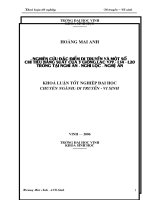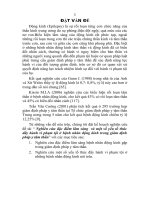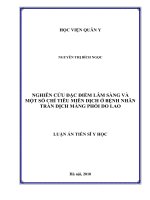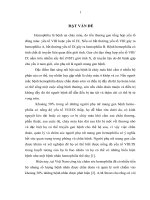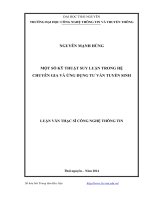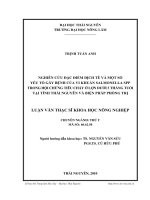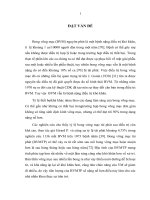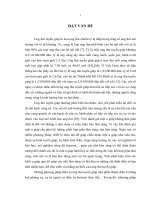Đặc điểm sinh sản và một số kỹ thuật ứng dụng nhằm cải thiện năng suất sinh sản của trâu
Bạn đang xem bản rút gọn của tài liệu. Xem và tải ngay bản đầy đủ của tài liệu tại đây (310.95 KB, 11 trang )
J. Sci. Dev. 2010, 8 (Eng.Iss.1): 100 - 110 HA NOI UNIVERSITY OF AGRICULTURE
100
CHARACTERISTICS OF REPRODUCTION OF THE WATER BUFFALO AND
TECHNIQUES USED TO IMPROVE THEIR REPRODUCTIVE PERFORMANCE
Đặc điểm sinh sản và một số kỹ thuật ứng dụng
nhằm cải thiện năng suất sinh sản của trâu
Nguyen Hoai Nam
Faculty of Veterinary Medicine, Hanoi University of Agriculture, Vietnam
Corresponding author : (066)874389148
TÓM TẮT
Thành thục muộn, động dục thầm lặng, khoảng cách lứa đẻ dài và sinh sản theo mùa là những
đặc điểm ảnh hưởng tới năng suất sinh sản của trâu. Nhiều biện pháp kỹ thuật đã được áp dụng
nhằm cải thiện hiệu quả sinh sản của loài gia súc này. Sử dụng hoóc-môn gây động dục sau đó thụ
tinh tại một thời điểm nhất định là kỹ thu
ật được ứng dụng nhiều và cho một số kết quả khả quan.
Gây rụng trứng nhiều hay hút trứng có thể thu được một số lượng lớn phôi, trứng trong một thời
gian ngắn nhưng tỷ lệ trứng phát triển đến giai đoạn thụ tinh và tỷ lệ thụ tinh trong phòng thí nghiệm
còn thấp. Cấy truyền phôi dù đạt được một số thành tựu nhưng hiệu quả của ph
ương pháp này chưa
ổn định. Nghiên cứu nhằm tăng năng suất sinh sản ở trâu nước là một vấn đề thiết yếu.
Từ khóa: Sự thụ tinh, sự rụng trứng, sinh sản, trâu nước.
SUMMARY
Late puberty, silent heat, long calving interval and seasonal breeding are characteristics those
hamper the reproductive performance of the water buffalo. Several techniques have been used to
improve their reproductive efficiency. Ovulation program - fixed time artificial insemination (Ovsynch-
TAI) has been applied as the most popular solution with prospective results. Superovulation
demonstrates a fairly low number of embryos per buffalo in each session. Ovum pick-up (OPU) is
superior to superovulation since it could yield quite a large amount of oocytes in a short time.
Unfortunately, in vitro maturation (IVM) and in vitro fertilization (IVF) rates are still low. Embryo
transfer has obtained some achievements. However, the efficacy of this technique is not really stable.
Further studies on improving efficiency of reproduction in the water buffalo are essential.
Key words: fertilization, ovulation, reproductive performance, water buffalo.
1. INTRODUCTION
The water buffalo contributes substantially to
the economy of many countries in tropic and
subtropic regions including Indian sub-continent,
China, South-East Asia, Mediterranean, South and
Central America, Africa and Australia. They are
classified into two distinct types as river and
swamp buffaloes. While the river type is distributed
largely in Indian sub-continent, Mediterranean
regions, Caribbean, Africa and South America, the
swamp buffalo is mostly found in China and South-
East Asia (Kumar et al. 2007).
The river buffalo is mainly used for milk,
rather than the meat and draft purposes while the
swamp buffalo is raised for power and meat as
well. There is a genetic difference in the number of
diploid chromosomes between river and swamp
buffaloes, viz 50 in the former and 48 in the latter.
Regardless of the difference, they could interbreed
and produce fertile progenies (Bongso et al. 1983).
The water buffalo is an ineffectively
reproductive animal due to several features
including late puberty, low population of ovarian
follicles, silent heat, variable time of ovulation,
Characteristics of reproduction of the water buffalo and techniques used to improve
101
seasonal breeding and long postpartum anestrus. To
improve the poorly reproductive efficiency of the
water buffalo, several techniques such as artificial
insemination, superovulation, ovum pick-up, in
vitro maturation, in vitro fertilization and embryo
transfer have been applied with various
achievements.
The purpose of this article is to summarize the
characteristics of reproduction in water buffaloes
and solutions used to improve their reproductive
performance.
2. CHARACTERISTICS OF REPRODUCTION
IN THE WATER BUFFALO
2.1. Late puberty
The age at puberty in buffaloes is much higher
than that in cattle. In the male buffalo, the
establishment of spermatogenesis is complete at the
age of 24 months (McCool and Entwistle, 1989)
compared with 4 months in cattle (Curtis and
Amann, 1981). Though sperm production of swamp
buffaloes is established at 12-15 months of age,
they do not show in the ejaculation until buffaloes
reach 2 years old (McCool and Entwistle, 1989).
In the female swamp buffalo, puberty appears
individually, seasonally, nutritionally and
managerially different. According to a research in
the Thai swamp buffalo, heifers reached puberty at
the age of 3-4 years old when they were at 55-60%
of their adult body weight (Bodhipaksha et al.
1987). In another research, the Thai swamp buffalo
obtained puberty at around 24-25 months old
(Kamonpatana et al. 1987). The swamp buffalo in
the Philippines was reported to show the first estrus
at the age of 26-29 months old while those in
Cambodia reached puberty at around 3 years old
and the swamp buffalo in Australia obtained
puberty, even more early, at under 2 years old
(Tulloch et al. 1981). In Vietnam, the female
swamp buffalo reached puberty at about 30-36
months old (Cong et al. 1983).
The age at puberty in river buffaloes also
varies considerably. When the calves are fed
sufficiently and sprayed with water during the hot
season, their puberty was found to appear very
early. Reports showed that puberty age ranged from
9.9 months to 24.7 months old in the Egyptian river
buffaloes (Mohamed et al. 1980, Hafez et al. 1955,
Salama et al. 1994, Barkawi et al. 1989). However,
other breeds such as Murrah, Surti and Nili-Ravi
were documented to obtain puberty later at 30-45.5
months old (Ishaq et al. 1972, Saini et al. 1998,
Sule et al. 2001).
2.2. Less primary follicles
The ovaries of buffaloes are smaller than those
of cattle. There are less recruitable follicles at any
given time in buffalo than those of the cattle. After
birth, the ovaries of buffaloes have about 12,000
(Danell et al. 1987) primary follicles compared
with 133,000 in cattle (Eriskson et al. 1966). The
transition from the growing follicles to the
secondary follicles stage is at a slow rate. The
number of secondary follicles is only 7.56% of the
growing follicles. Similarly, number of Graafian
follicles > 1 mm in diameter is less while the
follicular atresia is greater than that of cattle
(Noakes et al, 2001). This may be a cause of poor
reproductive performance in this type of animal.
2.3. Silent heat
Due to the low level of blood oestradiol-17
beta, the expression of estrus in buffaloes is very
poor. Silent heat is one of the deleterious features to
the reproductive performance in the buffalo. Estrus
often passes unoticedly, especially in the hot and dry
seasons when grass, wallowing pools and shades are
in deficiency which made the expression more
dubious. A research in the Pakistani river buffalo
showed that 51.5% of estrus was the silent heat
(Qureshi and Ahmad, 2008). According to a study in
the Egyptian river buffalo, there were two patterns of
follicular waves in which the three follicular waves
dominated the two follicular waves (Barkawi et al.
2009). In contrast, the one wave estrus cycles in the
Thai swamp buffalo were depicted to be 22.7%
while the two wave- patterns were 77.3%
(Promdireg et al., 2004). Study of the follicular
waves in the estrus cycles of the river buffalo
showed that the one follicular wave patterns were
quite usual (Awasthi et al. 2006). In one wave
model, the ovulatory follicles persisted much longer
than those in the 2 wave-pattern, and at the middle of
the cycle there was a regression before a
resurrection. The growth rate of ovulatory follicles
was, therefore, slower than that in the 2 wave-
patterns. The small size and slow growth rate of
ovulatory follicles in the one follicular wave estrus
were suggested to result in the low concentration of
estrogen which was one of the causes of the silent
heat in the river buffalo (Awasthi et al. 2007).
Furthermore, the oocytes ovulated from the small
sized follicles were hypothesized to have low quality
which brought about the low fertility and conception
Nguyen Hoai Nam
102
rate. For the proportion of silent heat much
outnumbers the proportion of one follicular wave
pattern and this pattern is only one of potential
causes of silent heat, this suggests that there are
various reasons rather than only follicular model. In
the studies of using PGF 2 alpha to induce the
luteolysis in buffaloes, the partial luteolysis was also
pointed out as a probable reason of the silent heat
(Dhaliwal et al. 1988, El-Belely et al. 1995).
2.4. Variable time of ovulation
The estrus cycle of the swamp buffalo was
reported to be between 11 and 38 days, with an
average of 21,5± 4.7 days, 79,2% of the estrus
being in the range of 17-26 days (Kanai and
Shimizu, 1983). More than 20% of them were too
long or too short. Duration of estrus in the swamp
buffalo varies widely. It may range from 9-27
hours. The ovulation may occur during 6-21 hours
after the end of estrus (Kanai and Shimizu, 1983).
The short estrus was hypothetically induced by the
one-wave cycle (Baruselli et al. 1996). This type of
follicular wave cycle also generates variable
durations of estrus which cause difficulties to the
estimation of ovulation and appropriate time of
artificial insemination.
The time of ovulation was reported to depend
on the protocols used to induce estrus (Warriach et
al. 2008). In the PGF2 alpha and GnRH-induced
estrus river buffaloes, the durations of standing
estrus were 14.2±0.8 and 8.9±0.6 h, respectively.
The intervals of ovulation after standing estrus
were 30,6±1,5h and 15,0±0,8h in the PGF
2
alpha
and GnRH–induced estrus buffaloes, respectively
(Warriach et al. 2008). The ovulatory response of
the river buffalo was found to be from 57.6%-
84.4% when eCG and CIRD were applied in
ovulation synchronization (Murugavel et al. 2009).
2.5. Seasonal breeding
The water buffalo is the multiestrus animal
and the sexual activities can occur all round year.
Nonetheless, the ovarian activities have shown to
be characterized by the seasonal low breeding
period during the hot season (Sule et al. 2001). The
water buffalo is heat intolerant by nature (Chiu,
2003) they need shade and water or mud to get rid
of the heat from the environment. In the summer,
while the temperature is high, pools of water
become disappear, grass is also scarce those factors
contribute to a decrease in activities in the buffalo
which results in weak libido in the male and poor
reproductive performance in the female.
The endocrine of both female and male
buffalo changes throughout the year. In the low
breeding season, the female river buffalo features a
high concentration of prolactin and low
concentration of progesterone and oestradiol-17beta
(Roy and Prakash, 2007). This endocrine pattern
may also be partially responsible for the low sexual
activities and low fertility in the buffalo in low
breeding season. The survival of embryo in the
uterus is impaired due to the deficiency of
progesterone in the hot season (Bahga and
Gangwar, 1988). Hot season was also proved to
adversely affect the number of oocytes collected
per animal and the subsequent results of somatic
cell nuclear transfer. In Vietnam, the optimum time
of the year for working with buffalo oocytes was
from January to April (Uoc et al. 2007).
In male African buffaloes, the level of
hormone testosterone and LH-receptors were
higher in the breeding season compared to those in
the low breeding season (Brown et al. 1991). In that
study, when the high testosterone bulls were treated
with GnRH or hCG the blood testosterone did not
increase. This suggested that the sexual activities of
those buffaloes in the breeding season were at peak.
Moreover, the ejaculate volume, sperm motility,
proportion of normal morphological spermatozoa
was much higher in the breeding season than those
in the low breeding season though the total amount
of spermatozoa was the same. This result
contradicted the conclusion that season did not
have deleterious effects on the sperm quality in the
swamp buffalo used as artificial insemination sires
in Thailand (Koonjaenak et al. 2007). However, in
that study, the experimented buffaloes were used in
semen collecting station for artificial insemination
where they were chosen, managed and taken care
of very strictly and carefully and might not
represent the buffaloes in the field.
The seasonal reproductive characteristic in
water buffalo also depends on melatonin excreted
from pineal gland during the night and represents
the endocrinal signal of the light-dark rhythm in the
environment (Zicarelli et al. 1997, Di Palo et al.
1997).
2.6. Long postpartum anestrus
The resumption of estrus postpartum is a
critical factor to achieve a satisfactory production
in buffaloes. In dairy cattle this period should be in
about 60-80 days and conception must be obtained
by 85-100 days post-calving to get desirable
Characteristics of reproduction of the water buffalo and techniques used to improve
103
benefits. Unfortunately, postpartum estrus in
buffaloes always comes much later than this figure.
The long postpartum anestrus in the buffalo
depends on several factors including: season of
calving, uterine involution, suckling, milk yield,
nutrition and body condition score at calving.
The Australian swamp buffalo experienced a
very wide range of postpartum anestrus period of
5.8 ± 3.3 months depending on the season of
calving (McCool et al. 1987). The buffaloes calved
in the spring seemed to have longer postpartum
anestrus period than those calved during August to
November. Significantly longer postpartum
anestrus of 47 ± 4 and 84 ± 10 days in the hot
season compared with 26 ± 4 and 40 ± 4 days in the
cold season were documented by Khattab et al.
(1995) and El-Sobhy et al. (1988), respectively.
Longer acyclic postpartum period in the low
breeding season than that in the breeding season
was also described by Qureshi et al. (1998) and
Perera et al. (1987). However, there were some
contradictions exposing when seasons were
approved to have no significant effects on the
length of postpartum intervals (Qureshi et al. 1999,
Patel et al. 1992, Mahdy et al. 2001).
Uterine involution is also a key factor that
impacts the time of postpartum anestrus in the
water buffaloes. Normally, the involution of uteri
would complete by 45 days post calving (Agrawal
et al. 1978). Nevertheless, in any detrimental
situations, this process is lengthened and results in
the prolonged postpartum anestrus interval. Of all
the uterine abnormalities, endometritis, perhaps, is
the most prevalent disease (Azawi et al 2008). It
was reported to be about 12.3% in a research on
genital tracts of Iraqi buffaloes. Other types of
metritis were also depicted however the occurrence
was much lower with the prevalence of hydrometra,
mucometra, pyometra were 0.2%, 0.7%, 0.49%,
respectively (Azawi et al. 2008). Endometritis was
also documented to be very high in Egyptian and
Iranian buffaloes: 22.4%-47.9% (Al-Fahad et al.,
2000; Alwan etal., 2001, Ghanem et al., 2002;
Moghaddam et al. 2004; Moghami et al. 1996).
Jainudeen et al. (1983) reported that uterine
involution was at 28±6 days and 32% of the
suckled Malaysian swamp buffaloes showed the
first ovulation after calving 90 days, 68% of them
were anestrus within 150 days postpartum.
Subclinical uterine infection was supposed to
slower the appearance of the first estrus post
calving (El-Sheikh and Mahamed, 1976).
Elongation of postpartum anestrus interval
was found in the river buffaloes those produced
more than 8kg of milk per day than those produced
less than 8 kg of milk per day (El-Fadaly et al.
1980, El-Azab et al. 1984). Suckling obviously
prolongs time of postpartum anestrus. Jainudeen et
al. (1984) reported the weaned buffaloes at 30 days
postpartum showed the first estrus earlier than
those were suckled of 42 ± 8 and 55 ± 10 days,
respectively. Similarly, milked buffaloes had longer
acyclic interval of 72 ± 11 days compared with 44
± 9 days in those who were weaned (Arya and
Madan, 2001). Free suckled buffaloes had longest
postpartum anestrus interval among restricted
suckled and early weaned buffaloes in which those
intervals were 82 ± 11 days, 69 ± 10 days and 50 ±
7 days, respectively (Nordin and Jainudeen., 1991).
Nutrition plays a considerably important role
in reproduction of water buffaloes. Shorter
postpartum anestrus period achieved in those
buffaloes who were fed high energy prepartum
compared with those were not was proved by
Salama et al. (1982) and Hegazy et al. (1994a).
Nutrition has a close relation to body condition of
the water buffaloes. In the buffaloes whose body
condition score are low, the self tissues are used for
the production of milk and other daily activities
then they do not have enough energy stored for the
next estrus cycle. This would elongate the interval
of postpartum anestrus. The thin buffaloes were
documented to be prolonged the time of acyclic
postpartum than those had moderate body condition
score; 63 days compared with 47 days (Hegazy et
al. 1994b). In both river and swamp buffaloes,
those had higher body condition were found to have
shorter postpartum anestrus interval than those had
lower body condition score (Baruselli et al., 2001).
In addition, in a research on the India river
buffalo by Palta and Madan, (1996), that the release
of LH and FSH in response to exotic GnRH were
progressively decreased with the advancement of
gestation and low response after parturition
regardless of the stable LH and FSH contents in the
pituitary may suggest that this is one of the reasons
of long postpartum anestrus in the buffalo.
Reproduction of water buffaloes is greatly
hampered by late attainment of puberty, seasonality
of breeding, long postpartum anestrus. Moreover,
silent heat and variable time of ovulation make the
estrus detection very difficult. All of those
mentioned characteristics bring about the poor
performance of both reproduction and production
of the water buffalo.
Nguyen Hoai Nam
104
3. IMPROVEMENT OF REPREDUCTIVE
PERFORMANCE IN THE SWAMP
BUFFALO
3.1. Artificial insemination
Artificial insemination (AI) has been used
widely on dairy and beef cattle with satisfactorily
stable conception rate whereas that in water
buffaloes was reported to be various and humble. AI
was mostly applied in buffaloes at fixed time
following the ovulation synchronization programs
(Ovsynch) which used several sexual hormones such
as GnRH, progesterone, PGF
2
-alpha, PMSG, LH and
estradiol-17 beta. The conception rates of water
buffaloes were reported to range from 22.2% to
37.5% when PRID (contained progesterone and
estradiol-17beta) and PMSG were used (Zicarelli et
al. 1997, Barile et al. 2001, Pacelli et al, 2001).
Neglia et al. (2003) found that the fertility rate of
buffaloes induced estrus by GnRH and PMSG was
from 28.2% to 36%. Similar results were also given
by Paul and Prakash, (2005) and Chaikhun et al.
(2009). According to these authors, when GnRH and
PGF2alpha were applied in the Ovsynch, pregnancy
rates of buffaloes were 30.7%-33.3% in the former
research and 34.6%-34.9% in the latter research. In
those studies, fixed time AI and AI at detected estrus
gave similar results. Study comparing the effects of
GnRH and LH in the Ovsynch conducted by de
Araujo Berber et al. (2002) showed quite high
fertility rates of 56.5% and 64.2%. By contrast, a
very poor fertility rate was also documented of
12.5%-25%(Honnappagol and Patil.,1991).
In the spontaneous estrus buffaloes, the
conception rate varies depending on the time at
which AI is performed. Kumaresan and Ansari,
(2001) conducted AI at 6-12h, 12-18h and 18-24h
on buffaloes after estrus, the pregnancy rates were
shown to be 16.67%, 28.99% and 33.33%,
respectively. Noncyclic buffaloes were announced
to achieve lower fertility rate of 4.7%-30%
compared with that of 35.7% - 51.5% in cyclic
buffaloes (De Rensis et al. 2005).
Low pregnancy rate in buffaloes might be
explained by that the embryonic mortality rate
between day 25 and day 40 post insemination was
reported to be very high of 21%-50% (Campanile et
al. 2005, Campanile et al. 2008, Vecchio et al.
2008).
3.2. Superovulation
For the low amount of primordial follicles in
the ovaries, the ovulation response in buffaloes is
much less effective than that in cattle. Progesterone
mare’s serum gonadotropin (PMSG) and follicle
stimulating hormone (FSH) have been the most
popular hormones used in superovulation programs.
Due to a long half life (Schams and Himmler,
1978), PMSG induces a second follicular wave
with anovulatory follicles after the first ovulation.
These follicles secrete a large amount of oestradiol-
17beta that far exceeds the preovulatory
concentration which results in an imbalance of
progesterone:oestradiol-17beta ratio in the
follicular fluid and unfavorable condition for the
maturation and implantation of the oocytes and
embryos in the oviduct and uterus (Schallenberger
et al. 1990). The use of monoclonal antibodies
against PMSG could reduce the peripheral inhibin
of superovulated buffaloes and resulted in better
results (Palta et al. 1996). Several efforts have been
also made to increase the response of ovaries and
production of embryos as well. The
supplementation of GnRH at the standing heat and
8-12h after standing heat was conducted
(Techakumphu et al., 2001). The numbers of
embryos recovered from two treated and control
groups were 2.33 ±2.24, 2.0±3.2, 1.91 ± 2.74,
respectively. Although the production of embryos
was not improved, the yield of transferable
embryos in the group treated with GnRH at 8-12h
after standing heat was highest. The use of
oestradiol-17 beta and eCG as supplementation was
reported to improve the ovarian stimulation in
swamp buffaloes in Vietnam (Uoc et al. 1992,
Nguyen et al. 1997). Number of recovered embryos
and percentage of transferable embryos were
documented to be of 3±1 and 75%, higher in the
buffaloes supplemented with recombinant bovine
somatotropin than those applied FSH alone, i.e.
0.8± 0.3 and 33 % (Songsasen et al. 1999).
Vlakhov et al. (1986) demonstrated that the
transferable embryos collected from each buffalo
used FSH ranging between 2.1-2.6 embryos/
buffalo. A higher production was shown in the
study by Misra et al. (1998). According to that
research, by using FSH, those authors could
recover 4.11 ± 2.46 embryos/ buffalo.
3.3. Ovum pick-up, in vitro maturation, in vitro
fertilization and embryo transfer
Ovum pick up in water buffaloes has
demonstrated low efficiency. The number of
oocytes collected in one session per animal is fairly
low. Manjunatha et al. (2008) could recover 1.21 ±
0.07 oocytes/buffalo. Similarly, the same authors
Characteristics of reproduction of the water buffalo and techniques used to improve
105
also collected 1.6±0.1 and 1.0±0.3 oocytes/buffalo
in the high and low breeding season, respectively
(Manjunatha et al. 2009). Researches on Thai
swamp buffaloes showed a higher amount of 5.33 -
7.75 oocytes recovered from one buffalo
(Techakumphu et al. 2004a; Techakumphu et al.
2004b). Those authors suggested that five repeat
cycles of FSH and OPU did not influence the
follicular response to the super-stimulation or the
number of oocytes from the pre-pubertal and
buffalo calves. Ovum pick-up was studied in
buffaloes in different reproductive status with the
similar results (Promdireg et al. 2005). The
efficiency of PMSG used in OPU was found to be
higher than that of FSH when the yields of oocytes
collected were 8.3 ± 5 and 4.6±3.2, respectively
(Techakumphu et al. 2000a). However, another
study by the same authors gave a contradicted
result when the application of FSH and GnRH
tended to reproduce more oocytes collected/buffalo
than those used PMSG and GnRH, i.e. 9.0±6.4 and
8.4±1.1, respectively (Techakumphu et al. 2000b).
In vitro maturation and in vitro fertilization
rates of buffalo oocytes are substantially various. A
very low maturation rate of only 3% was
announced by (Songsasen and Apimeteetumrong,
2002). This rate was improved by 23.5-42.5% in
the study by Wani et al. (2004). Several reports
showed that the maturation rate was ranged
between 52.2-86.2% (Manjunatha et al. 2007,
Techakumphu et al. 2000a, Uoc et al. 2007).
Fertilization rate of buffalo oocytes is not as high as
that in cattle. (Gasparrini et al., 2006) reported that
the cleavage of oocytes was 55-78.4% while the
rate of oocytes developed to the blastocyst stage
was 17.1-30.9%. The same authors also found that
the proportion of oocytes reached the stage of
morulae–blastocyst was 25.7-32.6% (Gasparrini et
al. 2004). In a research on Vietnamese swamp
buffalo oocytes, the ratio of oocytes those could
develop to blastocyst phase was 10.2-18.5% (Uoc
et al. 2007).
Embryo transfer in water buffalo has been
conducted by several scientists with considerably
variable results. The conception rate depends on the
synchronization between the donors and receivers
and fresh or frozen embryos. An overall pregnancy
rate of 26.4% was established in the Indian buffalo.
In that study, the conception rate was 40.7% in the
receivers those had the same synchrony with the
donors while the conception rates were 14.3% and
18.5% in the donors those were 12h deviatory
estrus at either side from the receivers (Misra et al.
1999). Those authors also reported that the
conception rates of buffalo transferred fresh and
frozen-thawed embryos were 25.7% and 37.5%,
respectively (Misra et al. 1990). These results
contradicted what was found in a research on
Chinese buffalo embryos. In that study, the
conception rates of buffaloes received fresh sexed
(26.5%) and unsexed (26.9%) embryos were higher
than those received frozen-thawed sexed (11.6%)
and unsexed (15.4%) embryos (Liang et al. 2008).
In another Chinese study, twenty-nine swamp
buffaloes were transferred fresh in vitro river and
F1 buffalo cross (river x swamp) embryos, 41.4%
recipients were pregnant and 10 calves were born
accounting for 34.5% (Liang et al. 2007). The
frozen effect on the conception rate was
demonstrated by Techakumphu et al. (2001).
Pregnancy rate in the fresh embryo transferred
buffaloes was 35.7%, much higher than that in
those transferred frozen-thawed embryos, i.e. 5.9%.
Low conception and calving rates were also
documented of 16.36% and 10.91%, respectively
(Hufana-Duran et al. 2004).
Certain of methods have been used to cope
with reproductive aspect of water buffaloes.
Artificial insemination, with some degree of
success, is a preferable choice. However, other
techniques such as superovulation, ovum pick-up,
in vitro maturation and in vitro fertilization have
limited application due to their low efficiency.
4. CONCLUSIONS
The water buffalo is characterized by
ineffectively reproductive performance. Late
puberty reduces the duration of fertile life of this
animal while silent heat and variable time of
ovulation cause the difficulty to the estrus detection
which results in either missing estrus unoticedly or
obtaining low conception rate. In addition,
seasonality of calving and long postpartum anestrus
also detrimentally harm the efficiency of the
buffalo’s reproduction.
Several techniques have been employed to
enhance the reproductive performance of the water
buffaloes with certain level of success in each.
However, no solution has been proved to be a
highly efficient method. Artificial insemination
needs the improvement related to the appropriate
time of AI. Superovulation and ovum pick-up are
obstructed by the low population of ovarian
Nguyen Hoai Nam
106
follicles. Poor oocytes fertilization rate is the weak
point of embryos in vitro production. In the future,
studies are required to determine the appropriate
time for fixed time artificial insemination, to
improve the rates of in vitro maturation, in vitro
fertilization and to ameliorate the pregnancy rate of
embryo transfer techniques.
Acknowledgement
The author is grateful to Assoc. Prof. Suneerat
Aiumlamai for her introducing the author into this
topic, also for her encouragements and advices.
REFERENCES
Agrawal, K.P., Raizada, B.C., Pandey, M.D.
(1978). Postparturient changes in the uterus of
buffalo cows. Indian J. Anim. Sci. 47, 492–503.
Al-Fahad TA, 2000. Morphological study of
abnormal cases of female reproductive system of
buffaloes in Basra Province. MSc Thesis,
College Veterinary Medicine, Baghdad
University, Baghdad, pp. 31–40.
Alwan AF, Abdul-Hammed AN, Khammas DJ.
(2001). A macroscopical study of abnormal
genitalia of Iraqi female bualoes. Iraqi J Vet
Sci, 14, 129–132.
Arya, J.S. and Madan, M.L. (2001). Post partum
reproductive cyclicity based on ovarian steroids
in suckled and weaned buffaloes. Buffalo J., 17
(3): 361-369.
Awasthi, M. K., Khare, A., Kavani, F. S.,
Siddiquee, G. M., Panchal, M. T., and Shah, R.
R. (2006). Is one-wave follicular growth during
the estrous cycle a usual phenomenon in water
buffaloes (Bubalus bubalis)? Anim Reprod Sci
92, 241-53.
Awasthi, M. K., Kavani, F. S., Siddiquee, G. M.,
Sarvaiya, N. P., and Derashri, H. J. (2007). Is
slow follicular growth the cause of silent estrus
in water buffaloes? Anim Reprod Sci 99, 258-68.
Azawi.O.I, Ali.A.J, Lazim.E.H. (2008).
Pathological and anatomical abnormalities
affecting buffalo cows reproductive tracts in
Mosul. Iraqi Journal of Veterinary Sciences.
Vol.22.No.2,2008 (59-67).
Bahga, C. S., and Gangwar, P. C. (1988). Seasonal
variations in plasma hormones and reproductive
efficiency in early postpartum buffalo.
Theriogenology 30, 1209-23.
Barile, V.L., Galasso, A., Marchiori, E., Pacelli, C.,
Montemurro, N. and Borghese, A. (2001). Effect
of PRID treatment on conception rate in
Mediterranean buffalo heifers. Livest. Prod.Sci.,
68: 283-287.
Barkawi, A.H., Mokhless, E.M. and Bedeir, L.H.
(1989). Environmental factors affecting age at
puberty in Egyptian buffaloes. Buffalo J., 5 (1):
71-78.
Barkawi, A. H., Hafez, Y. M., Ibrahim, S. A., Ashour,
G., El-Asheeri, A. K., and Ghanem, N. (2009).
Characteristics of ovarian follicular dynamics
throughout the estrous cycle of Egyptian buffaloes.
Anim Reprod Sci 110, 326-34.
Baruselli, P. S., Mucciolo, R. G., Visintin, J. A.,
Viana, W. G., Arruda, R. P., Madureira, E. H.,
and Molero-Filho, J. R. (1996). Ovarian
follicular dynamics during the estrus cycle in
buffalo (Bubalus bubalis). Preliminary research.
Ann N Y Acad Sci 791, 408-11.
Baruselli, P.S., Barnabe, V.H., Barnabe, R.C.,
Visintin, J.A., Molero-Filho, J.R. and Porto R.
(2001). Effect of body condition score at calving
on postpartum reproductive performance in
buffalo. Buffalo J., 17 (1): 53-65.
Bodhipaksha P.(1987). Physiology of female
swamp buffalo reproduction. In swamp Buffalo
Reproduction. Dept. Obstetrics Gynecology and
Reproduction, Fac Vet Sci;Chulalongkorn
University ed. 118p.
Bongso, T. A., Hilmi, M., and Basrur, P. K. (1983).
Testicular cells in hybrid water buffaloes
(Bubalus bubalis). Res Vet Sci 35, 253-8.
Brown, J. L., Wildt, D. E., Raath, J. R., de Vos, V.,
Howard, J. G., Janssen, D. L., Citino, S. B., and
Bush, M. (1991). Impact of season on seminal
characteristics and endocrine status of adult free-
ranging African buffalo (Syncerus caffer). J
Reprod Fertil 92, 47-57.
Campanile, G., Neglia, G., Gasparrini, B., Galiero,
G., Prandi, A., Di Palo, R., D'Occhio, M. J., and
Zicarelli, L. (2005). Embryonic mortality in
buffaloes synchronized and mated by AI during
the seasonal decline in reproductive function.
Theriogenology 63, 2334-40.
Campanile, G., Vecchio, D., Di Palo, R., Neglia,
G., Gasparrini, B., Prandi, A., Zicarelli, L., and
D'Occhio, M. J. (2008). Delayed treatment with
GnRH agonist, hCG and progesterone and
reduced embryonic mortality in buffaloes.
Theriogenology 70, 1544-9.
Chaikhun.T, Tharasanit.T, Techakumphu.M,
(2009). Efficiency of ovulation synchronization
and fixed –time artificial insemination program
Characteristics of reproduction of the water buffalo and techniques used to improve
107
in swamp bufflo in small holder farms. In:
Proceeding of the Second FASAVA Congress,
Bangkok, Thailand, pp 532-533.
Chiu,Y.H. (2003). Image of Taiwan
cattle. />hapter2Cattle_2.pdf. Cited: 25/01/2010.
Curtis, S. K., and Amann, R. P. (1981). Testicular
Development and Establishment of
Spermatogenesis in Holstein Bulls. J. Anim Sci.
53, 1645-1657.
Danell, B., (1987). Oestrus behaviour, ovarian
morphology and cyclical variation in the follicular
system and endocrine pattern in water buffalo
heifers. Ph.D Dissertation, Swedish University of
Agricultural Sciences. Uppsala, Sweden.
de Araujo Berber, R. C., Madureira, E. H., and
Baruselli, P. S. (2002). Comparison of two
Ovsynch protocols (GnRH versus LH) for fixed
timed insemination in buffalo (Bubalus bubalis).
Theriogenology 57, 1421-30.
De Rensis, F., Ronci, G., Guarneri, P., Nguyen, B.
X., Presicce, G. A., Huszenicza, G., and
Scaramuzzi, R. J. (2005). Conception rate after
fixed time insemination following ovsynch
protocol with and without progesterone
supplementation in cyclic and non-cyclic
Mediterranean Italian buffaloes (Bubalus
bubalis). Theriogenology 63, 1824-31.
Dhaliwal et al., G.S. Dhaliwal, R.D. Sharma and
G. Singh. (1988). Efficacy of prostaglandin F
2α
administration for inducing estrus in buffaloes,
Theriogenology 29 (1988), pp. 1401–1406.
Di Palo, R., Parmeggiani, A., Spadetta, M.,
Campanile, G., Esposito, L., Seren, E. and
Zicarelli,L. (1997). Influence of changing farm
on repeatability of melatonin plasma level in
Italian Mediterranean buffalo. In: Proc. Fifth
World Buffalo Congress, Caserta, Italy, 13-16
October:758-761.
Gasparrini, B., Boccia, L., Rosa, A. D., Palo, R. D.,
Campanile, G., and Zicarelli, L. (2004).
Chemical activation of buffalo (Bubalus bubalis)
oocytes by different methods: effects of aging on
post-pathogenetic development. Theriogenology
62, 1627-37.
Gasparrini, B., Boccia, L., Marchandise, J., Di
Palo, R., George, F., Donnay, I., and Zicarelli, L.
(2006). Enrichment of in vitro maturation
medium for buffalo (Bubalus bubalis) oocytes
with thiol compounds: effects of cystine on
glutathione synthesis and embryo development.
Theriogenology 65, 275-87.
Ghanem M, Shalaby AH, Sharawy S, Saleh N,
(2002). Factors leading to endometritis in Egypt
with special reference to reproductive
performance. J Reprod Sci 48, 371–375.
El-Azab, E.A., Mansour, H., Heshmat, H., Shawki,
G. (1984). The postpartum period and the future
fertility of the Egyptian buffalo. In: Proceedings
of the 10th International Congress on Animal
Reproduction and AI, vol. III, No. 424, Urbana,
p.3.
El-Belely et al., M.S. El-Belely, H.M. Eissa, H.E.
Omaima and I.M. Ghoneim. (1995).Assessment
of fertility by monitoring changes in plasma
concentration of progesterone, oestradiol 17-β,
androgens and estrone sulphate in subestrus
buffalo cows treated with prostaglandin F
2α
,
Anim. Reprod. Sci. 40 (1995), pp. 7–15.
El-Fadaly, M.A., (1980). Effect of suckling and
milking on the breeding efficiency of buffaloes.
I. First postpartum estrus. Vet. Med. J. (Giza)
28, 399–404.
El-Sheikh, A.S., Mohamed, A. (1976). First
postpartum estrus in buffaloes. Indian J. Anim.
Sci. 46, 580–583
El-Sobhy, H.E., Khalil, F.A., Abdelaal, A.E., El-
Fouly, M.A. (1988). Use of progesterone levels
in peripheral blood for studying reproductive
patterns of Egyptian buffaloes. In: Optimizing
Grazing Animal Productivity in Mediterranean
and North African Regions With the Use of
Nuclear Techniques. IAEA, Vienna, Austria, pp.
231–237.
Erickson, B. H. (1966). Development and
senescence of the postnatal bovine ovary. J.
Anim. Sci. 25:800–805.
Hafez, E.S.E. (1955). Puberty in the buffalo cow. J.
Agr. Sci., 46: 137-142.
Hegazy, M.A., El-Wishy, A.B., Youssef, A.H.,
Awadalla, S.A., Teleb, H.M. (1994a).
Interrelationship between pre-and/or post-partum
feeding levels, blood constituents and reproductive
performance of buffaloes. In: Proceedings of the
Fourth World Buffalo Congress, vol. III, San
Paulo, Brazil, pp. 632–633.
Hegazy, M.A., El-Essawy, S.A., El-Wishy, A.B.,
Youssef, A.H. (1994b). Effect of body condition
score on reproductive performance of buffaloes.
In: Proceedings of the Fourth World Buffalo
Congress, vol. III, Sao Paulo, Brazil, pp. 630-
631.
Honnappagol, S.S. and Patil, R.V. (1991). Oestrus
synchronization and fertility in buffalo heifers
Nguyen Hoai Nam
108
using Carboprost Tromethanine. Indian J. Anim.
Reprod., 12 (2): 177-179.
Hufana-Duran, D., Pedro, P. B., Venturina, H. V.,
Hufana, R. D., Salazar, A. L., Duran, P. G., and
Cruz, L. C. (2004). Post-warming hatching and
birth of live calves following transfer of in vitro-
derived vitrified water buffalo (Bubalus bubalis)
embryos. Theriogenology 61, 1429-39.
Ishaq, S.M. (1972). Ninth Annual Report.
Directorate of Livestock Farms, Punjab, Lahore.
Jainudeen, M.R., Bongso, T.A., Tan, H.S.,
(1982/1983). Postpartum ovarian activity and
uterine involution in the suckled swamp buffalo
(Bubalus bubalis). Anim. Reprod. Sci. 5, 181-190.
Jainudeen, M.R., Sharifuddin, W., Yap, K.C., Bakar
Dahari, A., (1984). Postpartum anestrus in the
swamp buffalo. In: The Use of Nuclear Techniques
to Improve Domestic Buffalo Production in Asia.
IAEA, Vienna, Austria, pp. 29-41.
Kamonpatana, M., Pansin, C., Timsard, V.,
Limsakul, A., Vechabusakorn, A., Savasri,
S.,Parnpai, R. and Pikultong, P. (1987).
Indication of puberty as related to fertility based
on bodyweight, age and profiles of reproductive
hormones in swamp buffaloes. Buffalo J., 3
(2):181-194.
Kanai, Y., and Shimizu, H. (1983). Characteristics
of the estrous cycle of the swamp buffalo under
temperate conditions. Theriogenology 19, 593-602.
Khattab, R.M., El-Wardani, M.A., Enaam, M.M.,
Barkawi, A.H., (1995). Patterns of ovarian
activity influencing calving interval of Egyptian
buffaloes in relation to season of calving. J. Agric.
Sci. Mansoura Univ. (Egypt) 20, 4331–4335.
Koonjaenak, S., Chanatinart, V., Aiumlamai, S.,
Pinyopumimintr, T., and Rodriguez-Martinez, H.
(2007). Seasonal variation in semen quality of
swamp buffalo bulls (Bubalus bubalis) in
Thailand. Asian J Androl 9, 92-101.
Kumar, S., Nagarajan, M., Sandhu, J. S., Kumar,
N., Behl, V., and Nishanth, G. (2007).
Mitochondrial DNA analyses of Indian water
buffalo support a distinct genetic origin of river
and swamp buffalo. Anim Genet 38, 227-32.
Kumaresan, A. and Ansari, M.R. (2001).
Evaluation of conception rate in buffaloes
(Bubalusbubalis) with reference to semen
quality, stage of oestrus and inseminator. Indian
J. Anim.Sci.,71 (2): 144-145.
Le Xuan Cong, (1983). Performances in
Vietnamese Swamp buffalo. Buffalo Bulletin, 2
(2):12-13.
Liang, X., Zhang, X., Yang, B., Cheng, M., Huang,
F., Pang, C., Qing, G., Liao, C., Wei, S.,
Senatore, E. M., Bella, A., and Presicce, G. A.
(2007). Pregnancy and calving rates following
transfer of in-vitro-produced river and F1 (river
x swamp) buffalo (Bubalus bubalis) embryos in
recipients on natural oestrus or synchronised for
ovulation. Reprod Fertil Dev 19, 670-6.
Liang, X. W., Lu, Y. Q., Chen, M. T., Zhang, X. F.,
Lu, S. S., Zhang, M., Pang, C. Y., Huang, F. X.,
and Lu, K. H. (2008). In vitro embryo
production in buffalo (Bubalus bubalis) using
sexed sperm and oocytes from ovum pick up.
Theriogenology 69, 822-6.
Mahdy, A.E., El-Shafie, O.M., Rigalaty, H.A.,
(2001). Relative importance of some factors
affecting performance traits in a herd of
Egyptian buffaloes. Alex. J. Agric. Res. 46, 1-18.
Manjunatha, B. M., Gupta, P. S., Devaraj, M.,
Ravindra, J. P., and Nandi, S. (2007). Selection
of developmentally competent buffalo oocytes
by brilliant cresyl blue staining before IVM.
Theriogenology 68, 1299-304.
Manjunatha, B. M., Ravindra, J. P., Gupta, P. S.,
Devaraj, M., and Nandi, S. (2008). Oocyte
recovery by ovum pick up and embryo
production in river buffaloes (Bubalus bubalis).
Reprod Domest Anim 43, 477-80.
Manjunatha, B. M., Ravindra, J. P., Gupta, P. S.,
Devaraj, M., and Nandi, S. (2009). Effect of
breeding season on in vivo oocyte recovery and
embryo production in non-descriptive Indian
river buffaloes (Bubalus bubalis) Anim Reprod
Sci 111, 376-83.
McCool, C.J., Townsend, M.P., Wolfe, S.G. and
Entwistle, K.W. (1987). Endocrinological studies
on pregnancy, post partum anoestrus and seasonal
variation of ovarian activity in the Australian
Swamp buffalo cow. Buffalo J.,1: 67-72.
McCool, C. J., and Entwistle, K. W. (1989). The
development of puberty and sexual maturity in
the Australian Swamp buffalo bull.
Theriogenology 32, 171-84.
Misra, A. K., Joshi, B. V., Agrawala, P. L., Kasiraj,
R., Sivaian, S., Rangareddi, N. S., and Siddiqui,
M. U. (1990). Multiple ovulation and embryo
transfer in Indian buffalo (Bubalus buoalis ).
Theriogenology 33, 1131-41.
Misra, A. K., Kasiraj, R., Rao, M. M., Rangareddy,
N. S., Jaiswal, R. S., and Pant, H. C. (1998).
Rate of transport and development of
preimplantation embryo in the superovulated
Characteristics of reproduction of the water buffalo and techniques used to improve
109
buffalo (Bubalus bubalis). Theriogenology 50,
637-49.
Misra, A. K., Rao, M. M., Kasiraj, R., Reddy, N.
S., and Pant, H. C. (1999). Factors affecting
pregnancy rate following nonsurgical embryo
transfer in buffalo (Bubalus bubalis): a
retrospective study. Theriogenology 52, 1-10.
Moghaddam AAI, Mamoei M, (2004). A survey on
some of the reproductive and productive traits of
the buffalo in Iran. 23rd World Buiatrics
Congress, Quebec, Canada, Abstract 2910.
Moghami SM, Saiyari M, Mayatri M, Sharma RN.
(1996). Pathology of uterus in buffalo
slaughtered in Ahwaz (Iran) abattoir. Buffalo J
12, 213–218.
Mohamed, A.A., El-Ashry, M.A. and El-Serafy,
A.M. (1980). Reproductive performance of
buffalo heifers bred at a young age. Indian J.
Anim. Sci., 50: 8.
Murugavel, K., Antoine, D., Raju, M. S., and
Lopez-Gatius, F. (2009). The effect of addition
of equine chorionic gonadotropin to a
progesterone-based estrous synchronization
protocol in buffaloes (Bubalus bubalis) under
tropical conditions. Theriogenology 71, 1120-6.
Neglia, G., Gasparrini, B., Di Palo, R., De Rosa, C.,
Zicarelli, L., and Campanile, G. (2003).
Comparison of pregnancy rates with two estrus
synchronization protocols in Italian
Mediterranean Buffalo cows. Theriogenology
60, 125-33.
Nguyen, T. U., Duong, D. L., van Ty, L., Chupin,
D., Renard, J. P., and Nguyen, B. X. (1997).
Effects of estradiol-17 beta and hCG
supplementation on superovulatory responses
and embryo quality in swamp buffalo (Bubalus
bubalis) implanted with norgestomet. Anim
Reprod Sci 47, 181-7.
Noakes,D.E., Parkinson,T.J., England, G.C.W.
(2001). Arthur’s veterinary reproduction and
obstetrics. W.B. Saunders press, 8th edition.
p.789.
Nordin, Y., Jainudeen, M.R. (1991). Effect of
suckling frequency on postpartum reproductive
performance of swamp buffaloes. In:
Proceedings of the Third World Buffalo
Congress, vol. II, Sofia, Bulgaria, pp. 737–743.
Pacelli, C., Barile, V.L., Lenza, R., Terzano, M.G.,
Montemurro, N. and Borghese, A.
(2001).Comparison of two different doses of
PMSG on conception rate in Mediterranean
buffalo heifers treated with PRID. In: Proc. Sixth
World Buffalo Congress, Maracaibo, Venezuela,
20-30 May:160-165.
Palta, P., and Madan, M. L. (1996). Effect of
gestation on GnRH-induced LH and FSH release
in buffalo (Bubalus bubalis). Theriogenology 46,
993-8.
Patel, K.K., Ninan, J., Suthar, B.N., Kavani, F.S.
(1992). Factors affecting fertile postpartum
estrus in Mensoni buffaloes. Cheiron 21, 39–43.
Perera, B.M.A.O., de Silva, L.N.A., Kuruwita,
V.Y., Karunaratne, A.M. (1987). Postpartum
ovarian activity, uterine involution and fertility
in indigenous buffaloes at a selected village
location in Sri Lanka. Anim. Reprod. Sci. 14,
115–127.
Paul, V., and Prakash, B. S. (2005). Efficacy of the
Ovsynch protocol for synchronization of
ovulation and fixed-time artificial insemination
in Murrah buffaloes (Bubalus bubalis).
Theriogenology 64, 1049-60.
Promdireg A , Na-Chiangmai A., Techakumphu
M, (2004). Follicular dynamics in swamp
buffalo cows (Bubalus bubalis). The 30th
Veterinary Medicine and Livestock De-
velopment Annual Conference, The Thai
Veterinary Medical Association Under the Royal
Patronage,Bangkok, p74
Promdireg, A., Adulyanubap, W., Singlor, J., Na-
Chiengmai, A., and Techakumphu, M. (2005).
Ovum pick-up in cycling and lactating
postpartum swamp buffaloes (Bubalis bubalis).
Reprod Domest Anim 40, 145-9.
Qureshi, M.S., Samad, H.A., Nazir Ahmad, N.,
Habib, G., Anjun, A.D., Siddiqui, M.M., (1998).
Reproductive performance of dairy buffaloes
under peri-urban commercial farming in VWFP,
Pakistan. Pakistan Vet. J. 18, 197–201.
Qureshi, M.S., Samad, H.A., Habib, G., Usmani,
R.H., Siddiqui, M.M., (1999). Study on factors
leading to seasonality of reproduction in dairy
buffaloes. I. Nutritional factors. Asian-Aus. J.
Anim. Sci. 12, 1019–1024.
Qureshi, M. S., and Ahmad, N. (2008). Interaction
of calf suckling, use of oxytocin and milk yield
with reproductive performance of dairy
buffaloes. Anim Reprod Sci 106, 380-92.
Roy, K. S., and Prakash, B. S. (2007). Seasonal
variation and circadian rhythmicity of the
prolactin profile during the summer months in
repeat-breeding Murrah buffalo heifers. Reprod
Fertil Dev 19, 569-75.
Nguyen Hoai Nam
110
Saini, M.S., Dhanda, O.P., Singh, N. and Georgie,
G.C. (1998). The effect of improved
management on the reproductive performance of
pubertal buffalo heifers during the summer.
Indian J. Dairy Sci., 51 (4): 250-253.
Salama, A.A., Ali, H.M., Shokry, M.M., (1982).
The effect of feeding different energy levels on
the reproductive performance of buffalo. In:
Proceedings of the Second World Congress on
Genetics Applied to Livestock Production,
Madrid, Spain, pp. 410–417.
Salama, M.A.M., Mokhless, E.M. and Barkawi,
A.H. (1994). Pubertal performance of Egyptian
buffalo heifers. Buffalo J., 10 (1): 61-66
Schallenberger, E., Wagner, H. G., Papa, R., Hartl,
P., and Tenhumberg, H.(1990). Endocrinological
evaluation of the induction of superovulation
with PMSG in water buffalo (Bubalus bubalis).
Theriogenology 34, 379-92.
Schams, D., and Himmler, V. (1978). The effect of
reduced water in take on peripheral plasma
levels of prolactin in heifers. Horm Metab Res
10, 360.
Songsasen, N., Yiengvisavakul, V., Buntaracha, B.,
Pharee, S., Apimeteetumrong, M., and
Sukwongs, Y. (1999). Effect of treatment with
recombinant bovine somatotropin on responses
to superovulatory treatment in swamp buffalo
(Bubalus bubalis). Theriogenology 52, 377-84.
Songsasen, N., and Apimeteetumrong, M. (2002).
Effects of beta-mercaptoethanol on formation of
pronuclei and developmental competence of
swamp buffalo oocytes. Anim Reprod Sci 71,
193-202.
Sule, S.R., Taparia, A.L., Jain, L.S. and Tailor, S.P.
(2001). Reproductive status of Surti buffaloes
maintained under sub-humid conditions of
Rajasthan. Indian Vet. J., 78 (11): 10491051
Techakumphu, M., Lohachit, C., Tantasuparak, W.,
Intaramongkol, C., and Intaramongkol, S.
(2000a). Ovarian responses and oocyte recovery
in prepubertal swamp buffalo (Bubalus bubalis)
calves after FSH or PMSG treatment.
Theriogenology 54, 305-12.
Techakumphu, M., Phutikanit, N., Suadsong, S.,
Bhumibhamon, T., Pita, A., and Coygasem, G.
(2000b). The effect of GnRH supplement of
FSH and PMSG treatments for prepubertal
swamp buffalo calves (Bubalus bubalis). J Vet
Med Sci 62, 269-72.
Techakumphu, M., Sukavong, Y., Intaramongko,
S., and Intaramongkol, J. (2001). The effect of
gonadotropin releasing hormone on
superovulation in elite swamp buffalo cows
(Bubalus bubalis). J Vet Med Sci 63, 853-7.
Techakumphu, M., Promdireg, A., Na-Chiengmai,
A., and Phutikanit, N. (2004a). Repeated oocyte
pick up in prepubertal swamp buffalo (Bubalus
bubalis) calves after FSH superstimulation.
Theriogenology 61, 1705-11.
Techakumphu, M., Promdireg, A., Phutikanit, N.,
Nachiengmai, A., and Thongjan, S. (2004b).
Transvaginal follicle aspiration in Thai swamp
buffalo heifers using different vacuum pressures
after FSH pretreatment (Bubalus bubalis). J Vet
Med Sci 66, 973-5.
Tulloch, D.G. and Grassia, A.A. (1981). A study of
reproduction in the Water Buffalo in
theNorthern Territory of Australia. Australian
Wildlife Res., 8: 335-348.
Uoc, N. T., Nguyen, B. X., Ty, L. V., Chupin, D.,
Beckers, J. F., and Renard, J. P. (1992). Effect of
estradiol supplementation on superovulation in
Swamp buffalo. Theriogenology 38, 471-8.
Uoc, N. T., de Rennis, F., Duc, N. H., Bui, L. C.,
Hanh, N. V., Linh, N. V., Thanh, N. T., Huu, Q.
X., Long, D. D., and Nguyen, B. X. (2007).
Effect of season on quality of oocytes, results of
in vitro maturation, and somatic cell nuclear
transfer in swamp buffalo. Reproduction,
Fertility and Development 19, 163-164.
Vecchio, D., Neglia, G., Di Palo, R., Prandi, A.,
Gasparrini, B., Balestrieri, A., D'Occhio, M. J.,
Zicarelli, L., and Campanile, G. (2008). Is a
Delayed Treatment with GnRH, hCG or
Progesterone Beneficial for Reducing
Embryonic Mortality in Buffaloes? Reprod
Domest Anim.
Vlakhov, K., Karaivanov, K., Petrov, M., and
Kacheva, D. (1986). [Superovulation and the
production of embryos in the water buffalo
(Bubalus bubalis) in Bulgaria]. Vet Med Nauki
23, 84-8.
Warriach, H. M., Channa, A. A., and Ahmad, N.
(2008). Effect of oestrus synchronization
methods on oestrus behaviour, timing of
ovulation and pregnancy rate during the
breeding and low breeding seasons in Nili-Ravi
buffaloes. Anim Reprod Sci 107, 62-7.
Zicarelli, L. (1997). Reproductive seasonality in
buffalo. Bubalus bubalis, 4, Suppl.: 29 - 52.

